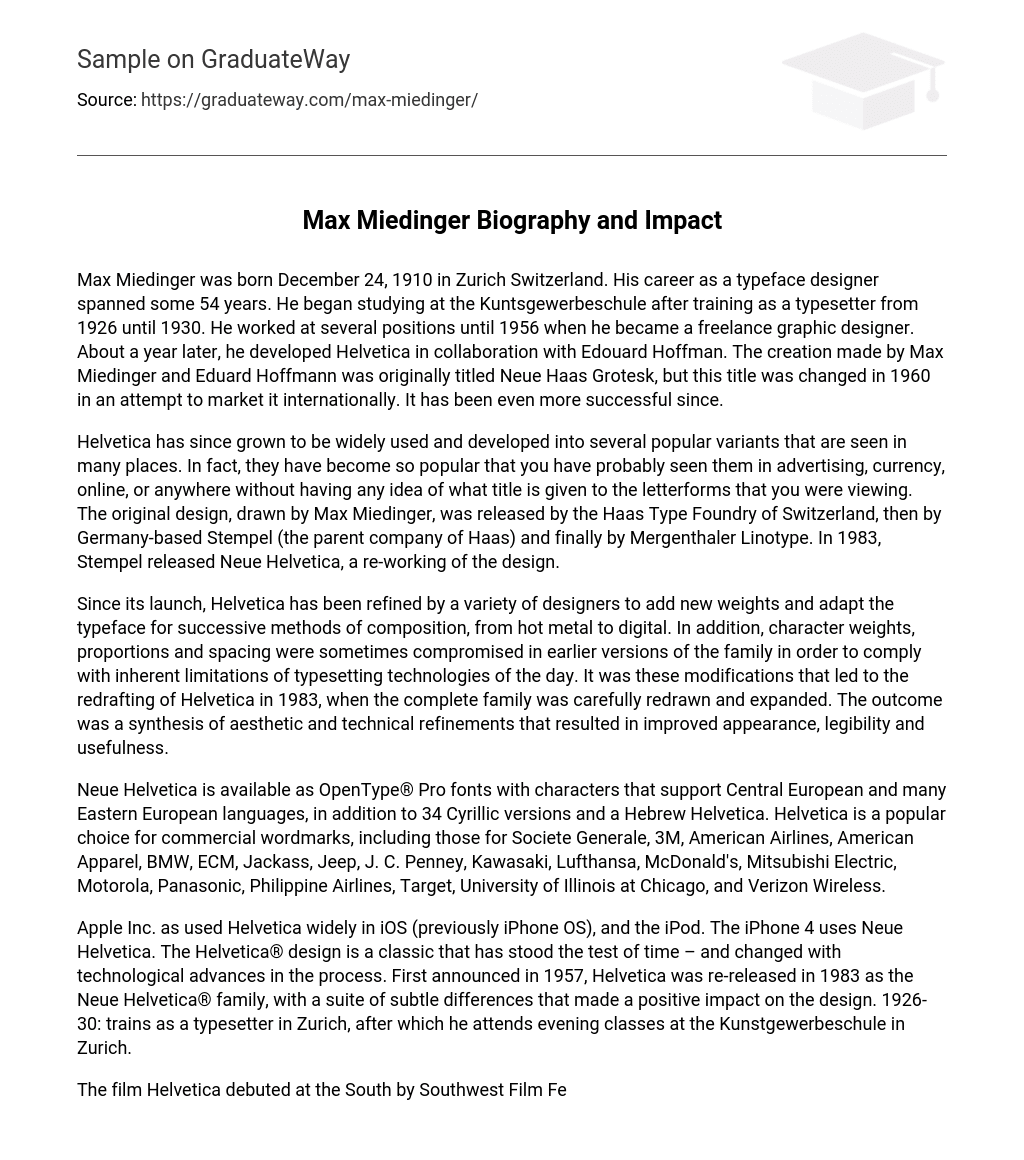Max Miedinger was born December 24, 1910 in Zurich Switzerland. His career as a typeface designer spanned some 54 years. He began studying at the Kuntsgewerbeschule after training as a typesetter from 1926 until 1930. He worked at several positions until 1956 when he became a freelance graphic designer. About a year later, he developed Helvetica in collaboration with Edouard Hoffman. The creation made by Max Miedinger and Eduard Hoffmann was originally titled Neue Haas Grotesk, but this title was changed in 1960 in an attempt to market it internationally. It has been even more successful since.
Helvetica has since grown to be widely used and developed into several popular variants that are seen in many places. In fact, they have become so popular that you have probably seen them in advertising, currency, online, or anywhere without having any idea of what title is given to the letterforms that you were viewing. The original design, drawn by Max Miedinger, was released by the Haas Type Foundry of Switzerland, then by Germany-based Stempel (the parent company of Haas) and finally by Mergenthaler Linotype. In 1983, Stempel released Neue Helvetica, a re-working of the design.
Since its launch, Helvetica has been refined by a variety of designers to add new weights and adapt the typeface for successive methods of composition, from hot metal to digital. In addition, character weights, proportions and spacing were sometimes compromised in earlier versions of the family in order to comply with inherent limitations of typesetting technologies of the day. It was these modifications that led to the redrafting of Helvetica in 1983, when the complete family was carefully redrawn and expanded. The outcome was a synthesis of aesthetic and technical refinements that resulted in improved appearance, legibility and usefulness.
Neue Helvetica is available as OpenType® Pro fonts with characters that support Central European and many Eastern European languages, in addition to 34 Cyrillic versions and a Hebrew Helvetica. Helvetica is a popular choice for commercial wordmarks, including those for Societe Generale, 3M, American Airlines, American Apparel, BMW, ECM, Jackass, Jeep, J. C. Penney, Kawasaki, Lufthansa, McDonald’s, Mitsubishi Electric, Motorola, Panasonic, Philippine Airlines, Target, University of Illinois at Chicago, and Verizon Wireless.
Apple Inc. as used Helvetica widely in iOS (previously iPhone OS), and the iPod. The iPhone 4 uses Neue Helvetica. The Helvetica® design is a classic that has stood the test of time – and changed with technological advances in the process. First announced in 1957, Helvetica was re-released in 1983 as the Neue Helvetica® family, with a suite of subtle differences that made a positive impact on the design. 1926-30: trains as a typesetter in Zurich, after which he attends evening classes at the Kunstgewerbeschule in Zurich.
The film Helvetica debuted at the South by Southwest Film Festival in 2007. Since that time, the discussion based biographical movie has been shown in over 300 cities in 40 countries. Helvetica looks at the whole picture and describes the impact that typefaces like Helvetica have in our lives and in urban spaces. This film not only goes so far as to celebrate the 50th anniversary of the typeface but also goes on to use Helvetica as a catalyst o a conversation that speaks of graphic design and our society as a whole, and how it reacts to typography and the visual images we are bombarded with daily. Neue Helvetica is a reworking of the typeface with a more structurally unified set of heights and widths. It was developed at D. Stempel AG, a Linotype subsidiary. The studio manager was Wolfgang Schimpf, and his assistant was Reinhard Haus; the manager of the project was Rene Kerfante. Erik Spiekermann was the design consultant and designed the literature for the launch in 1983.
Other changes include improved legibility, heavier punctuation marks, and increased spacing in the numbers. Neue Helvetica uses a numerical design classification scheme, like Univers. The font family is made up of 51 fonts including 9 weights in 3 widths (8, 9, 8 in normal, condensed, extended widths respectively), and an outline font based on Helvetica 75 Bold Outline (no Textbook or rounded fonts are available). Linotype distributes Neue Helvetica on CD. Neue Helvetica also comes in variants for Central European and Cyrillic text.





